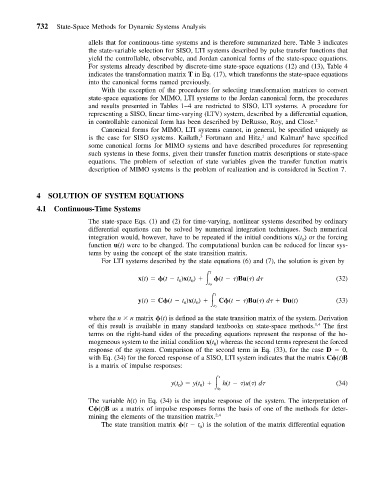Page 741 - Mechanical Engineers' Handbook (Volume 2)
P. 741
732 State-Space Methods for Dynamic Systems Analysis
allels that for continuous-time systems and is therefore summarized here. Table 3 indicates
the state-variable selection for SISO, LTI systems described by pulse transfer functions that
yield the controllable, observable, and Jordan canonical forms of the state-space equations.
For systems already described by discrete-time state-space equations (12) and (13), Table 4
indicates the transformation matrix T in Eq. (17), which transforms the state-space equations
into the canonical forms named previously.
With the exception of the procedures for selecting transformation matrices to convert
state-space equations for MIMO, LTI systems to the Jordan canonical form, the procedures
and results presented in Tables 1–4 are restricted to SISO, LTI systems. A procedure for
representing a SISO, linear time-varying (LTV) system, described by a differential equation,
in controllable canonical form has been described by DeRusso, Roy, and Close. 2
Canonical forms for MIMO, LTI systems cannot, in general, be specified uniquely as
3
9
1
is the case for SISO systems. Kailath, Fortmann and Hitz, and Kalman have specified
some canonical forms for MIMO systems and have described procedures for representing
such systems in these forms, given their transfer function matrix descriptions or state-space
equations. The problem of selection of state variables given the transfer function matrix
description of MIMO systems is the problem of realization and is considered in Section 7.
4 SOLUTION OF SYSTEM EQUATIONS
4.1 Continuous-Time Systems
The state-space Eqs. (1) and (2) for time-varying, nonlinear systems described by ordinary
differential equations can be solved by numerical integration techniques. Such numerical
integration would, however, have to be repeated if the initial conditions x(t ) or the forcing
0
function u(t) were to be changed. The computational burden can be reduced for linear sys-
tems by using the concept of the state transition matrix.
For LTI systems described by the state equations (6) and (7), the solution is given by
t
x(t) (t t )x(t ) (t )Bu( ) d (32)
0 0
t 0
t
y(t) C (t t )x(t ) C (t )Bu( ) d Du(t) (33)
0
0
t 0
where the n n matrix (t)isdefined as the state transition matrix of the system. Derivation
of this result is available in many standard textbooks on state-space methods. 1,4 The first
terms on the right-hand sides of the preceding equations represent the response of the ho-
mogeneous system to the initial condition x(t ) whereas the second terms represent the forced
0
response of the system. Comparison of the second term in Eq. (33), for the case D 0,
with Eq. (34) for the forced response of a SISO, LTI system indicates that the matrix C (t)B
is a matrix of impulse responses:
t
y(t ) y(t ) h(t )u( ) d (34)
0
0
t 0
The variable h(t) in Eq. (34) is the impulse response of the system. The interpretation of
C (t)B as a matrix of impulse responses forms the basis of one of the methods for deter-
mining the elements of the transition matrix. 2,4
The state transition matrix (t t ) is the solution of the matrix differential equation
0

